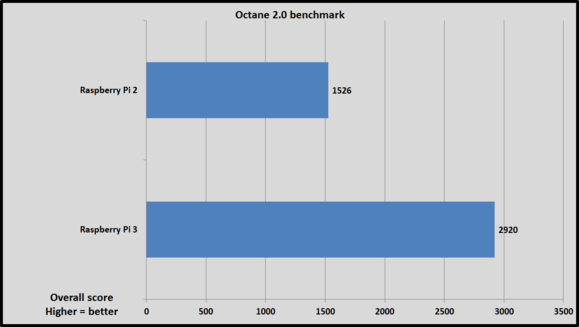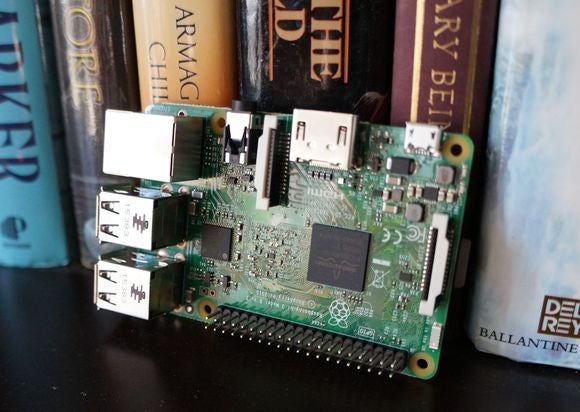Raspberry Pi 3 : The revolutionary $35 mini-PC cures its biggest headaches
-
The Raspberry Pi Foundation Raspberry Pi 3 Model B
At first blush, the Raspberry Pi 3 Model B appears physically identical to the year-old Raspberry Pi 2 Model B: the same port selection, the same GPIO pin layout, the same basic board layout, et cetera. But don’t let that fool you! The leap to the Raspberry Pi 3 is just as significant as the prior upgrade, supercharging performance even further and eliminating what few lingering setup hassles remained in the Raspberry Pi formula, all while maintaining the same dirt-cheap $35 price point.
But while the Raspberry Pi 3 is easily the most convenient and powerful Raspberry Pi ever, and the first that can potentially be used as a proper PC, it’s still more of an evolutionary upgrade than a revolutionary one—which is actually a good thing, as it helps the RP3 maintain backward compatibility with previous generations of the beloved mini-PC and maker board.
Official distributor Element 14 sent us a Raspberry Pi3 Model B to test, so without further ado, let’s dig in!

Faster, better, harder, stronger
The appeal of the Raspberry Pi has always laid in what you do with it rather than raw tech specs, but it’s the hardware that lets you create surprisingly practical Raspberry Pi projects and insanely creative inventions alike. Before we dive into the changes and performance, here’s a quick spec breakdown:SoC: Broadcom BCM2837 64-bit system-on-chip with four ARM Cortex-A53 CPU cores clocked 1.2GHzThe card-sized Raspberry Pi 3’s newfound power lies in a trio of upgrades: A new system-on-chip (SoC) with more potent graphics and computing capabilities, onboard 2.4GHz 802.11n Wi-Fi, and onboard Bluetooth 4.1/Low Energy support.
CPU: 4X ARM Cortex-A53, 1.2GHz
GPU: Broadcom VideoCore IV
RAM: 1GB LPDDR2 (900MHz)
Networking: 10/100 ethernet, 2.4GHz 802.11n wireless
Bluetooth: Bluetooth 4.1 Classic, Bluetooth Low Energy
Storage: microSD
GPIO: 40-pin header, populated
Ports: HDMI, 3.5mm analogue audio-video jack, 4X USB 2.0, ethernet, Camera Serial Interface (CSI), Display Serial Interface (DSI)
The new features seem insignificant on paper, but they add up to a serious usability boost in the real world—especially the onboard wireless capabilities, which just plain work out of the box with the default/recommended Raspbian operating system. Developing a Raspberry Pi-specific OS to work solely with Raspberry Pi hardware pays dividends in ease of use, it seems, especially since standard Linux installations are notorious for finicky wireless connectivity. The mere fact that integrated Wi-Fi exists is a huge step up from previous Raspberry Pi models, which required you either to pony up cash for a Wi-Fi adapter or hardwire your board via an ethernet connection.

Adding the wireless capabilities didn’t increase the Raspberry Pi’s overall footprint, either. The new wireless radio is so small that “its markings can only be properly seen through a microscope or magnifying glass,” the Raspberry Pi Foundation boasts.
The Raspberry Pi 3’s new SoC also gives it a big leg-up in performance over the Raspberry Pi 2, which itself blew the single-core original Raspberry Pi out of the water. The Raspberry Pis 2 and 3 both rock quad-core processors, but the latest edition features a quartet of Cortex-A53 CPU cores clocked at 1.2GHz, compared to the Raspberry Pi 2’s 900MHz ARM Cortex-A7 cores. In other words, the Raspberry Pi 3 has more capable cores running at higher clock speeds. Both pack a Broadcom VideoCore IV graphics processor, but the speed’s been bumped from 250MHz to 400MHz in the Raspberry Pi 3.

More important is just how much the Raspberry Pi 3 fails to remind you that you’re using a $35 computer. Previous versions suffered from annoying pauses and lag when performing even basic tasks like checking Gmail or managing documents with LibreOffice, but those headaches are largely gone in the Raspberry Pi 3. You won’t confuse it for a Windows desktop or even a Chromebook, but when Raspberry Pi Foundation founder Eben Upton said “This 50–60 percent [performance improvement] has moved us over some sort of line, where it becomes a much more credible PC replacement,” he wasn’t lying. The Raspberry Pi 3 can definitely handle basic productivity tasks and web browsing.
Though the Raspberry Pi’s ARM-based processors render it incompatible with many major benchmarks, we ran a handful of tests to quantify the generational improvement. To do so, we loaded the Raspberry Pi 2 and Raspberry Pi 3 with the latest Raspbian Jessie build maintained on the Raspberry Pi website.




And remember: The Raspberry Pi 2 delivered four to five times more performance than the original Raspberry Pi, so if you upgrade from the original model to the Raspberry Pi 3, prepare to be blown away by its speed.
The whole Pi
It’s impressive how (relatively) potent the $35 Raspberry Pi 3 can be, but the board won’t work by itself. You’ll need to connect it to a monitor or TV via HDMI; connect it to power via a 5-volt micro-USB cord capable of drawing 2.5 amps from the wall (I used a Kindle Fire charger; my Moto X’s charger wasn’t sufficient); and connect yourself via a USB or Bluetooth keyboard and mouse, though you’ll need to set it up using USB peripherals before you can activate Bluetooth pairing. Grabbing a case or at least a box to house the Pi is a swell idea too, because the board is fully exposed in its default state. Brad Chacos
Brad Chacos We tested the Raspberry Pi 3 with Raspbian, the Raspberry Pi Foundation’s officially supported operating system. The Foundation’s Noobs installer tool and setup guide makes getting your Raspberry Pi up and running relatively easy-peasy, even if OS installations aren’t your normal cup of tea.
Raspbian’s a fairly stripped-down operating system that drives home the Foundation’s original goal for the Raspberry Pi—to create an affordable computer that children can use to learn computer science.

Raspbian also houses a central “Pi Store” with hundreds and hundreds of additional tools, or you can always take the code-centric focus to heart and grab new software via a Terminal window. (Read: the command line.) Raspbian offers everything you need in a basic operating system.
Bottom line

Further reading: Mini-PC invasion: These radically tiny computers fit in the palm of your handOn paper, the Raspberry Pi 3 is just a more capable version of its predecessors, but it’s so much more than that in reality. While the Raspberry Pi 2 cured the original model’s pokey performance and paltry port selection, the Raspberry Pi 3’s extra oomph and new wireless capabilities help push it over a crucial usability hump. The connectivity hassles are gone. The slow and stuttering core experience feels smooth—or at least smooth enough—now. You no longer have to fight with the Raspberry Pi just to use it.
And the Raspberry Pi 3 manages to achieve all that despite sticking to the same $35 price point. If you’ve ever had any interest in picking up a Raspberry Pi to tinker with, or simply want a dirt-cheap productivity computer, HTPC, or file server, the Raspberry Pi 3 comes highly recommended. It’s delicious
Commentaires
Enregistrer un commentaire